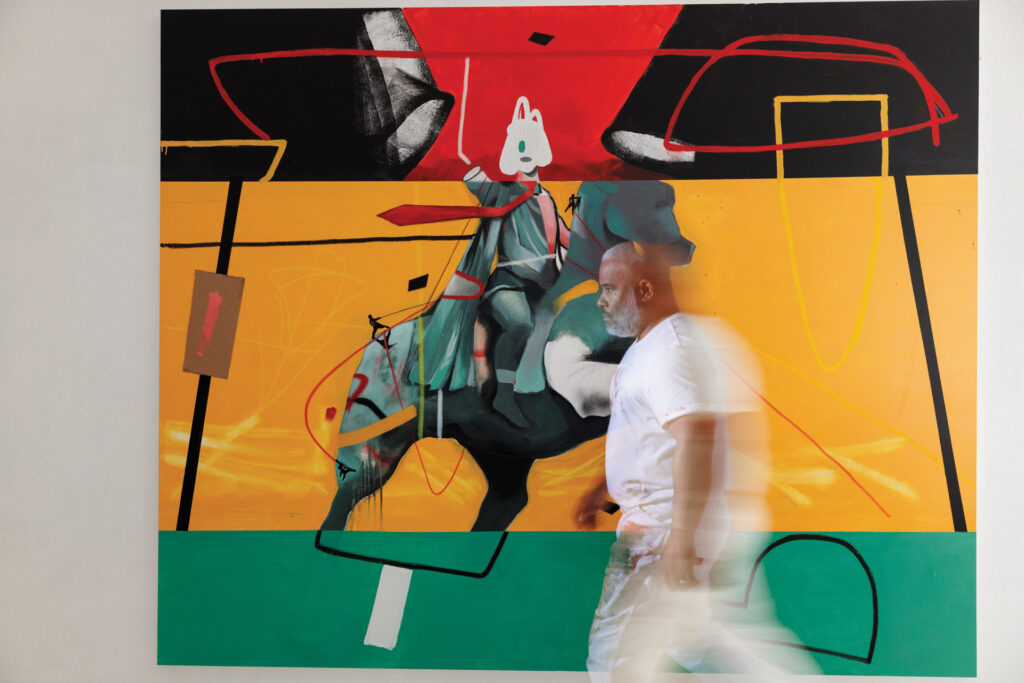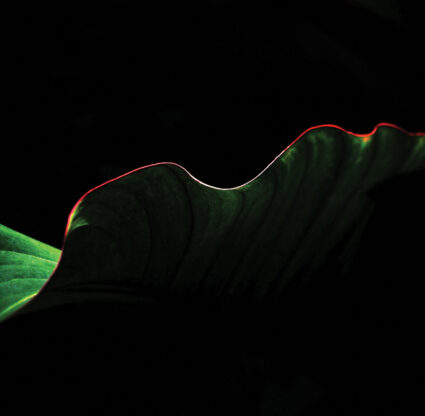For more than a decade, Marcus Jansen opened the doors to his Unit A studio on Martin Luther King Jr. Boulevard, allowing passersby to stop in for a chat while he filled canvases with his message-driven imagery. These days, the artist revels in solitude as he slings paint within the confines of his new white-walled fortress in downtown Fort Myers. “Now, if I do a show, there’s a lot of press and a certain amount of limelight,” he says with a faint grimace. He bought the new space on the heels of gaining representation from a major international art force, Almine Rech Gallery. “To get to the career that I have now required a lot of tactical moves,” Marcus says. “There’s an army behind me.”
As a Gulf War veteran, whose unit was among the last to leave the Middle East, Marcus speaks without equivocation. In the past few years, the artist has catapulted into the art world’s rock-star territory. After decades of dogged hustle and punchy successes, scoring a new studio fueled his already-formidable fire. Known for championing fellow Black artists, and long respected for his lack of hubris and under-the-radar philanthropy, Marcus downplays it all. “There’s been a lot of shifts,” he says simply.
Marcus speaks softly, but decisively, as he names European museums in his New York accent. He’s Southwest Florida’s only blue-chip artist since contemporary juggernaut Robert Rauschenberg passed away in 2008 on Captiva Island. Marcus’ work has been in Architectural Digest and The New York Times, snapped up by pop star Nicole Scherzinger and basketball phenom Carmelo Anthony, and in institutions from The Bronx Museum of the Arts to the Smithsonian. Marcus’ solo exhibition at Orlando’s Rollins Museum of Art in late 2020, E Pluribis Unum, prompted Richard Beavers—his longtime dealer with two eponymous galleries in New York—to share Marcus’ work with a fellow gallerist and collaborator. She just happened to be Almine Rech, the wife of Pablo Picasso’s grandson, Bernard. Her galleries continue the legacy of Picasso’s avant-garde approach to painting. Impressed, Almine mounted three solo shows for Marcus in her London and Paris locations within two years. “She’s given me the confidence to paint what I need to paint, because she’s an artist herself,” he says. “Even as a gallerist and dealer, she’s not from the outside looking in.”
Now selling exclusively through Almine and Richard, Marcus can dedicate more time to the works that fuel him. Marcus considers his paintings, often labeled ‘urban expressionism,’ to be somewhat autobiographical. “All topics I address are personal experiences,” he says. “So, you can tie almost everything I paint back to me. I use introverted feelings on an extroverted platform.” Marcus’ imagery ranges from street scenes to aerial views to imposing, single figures, all painted loosely, embedded in fields of almost-lacquered color or webs of abstracted marks with a slight graffiti influence. Now that he owns his space, there’s a fresh sense of security leading the artist to reflect more on himself and, in turn, his pieces appear almost as self-portraits. In Afro Painter, a solitary figure stands in a dark hallway with arms outstretched in every direction—a reflection of the constant hustle throughout Marcus’ career.
When his lease was up on Unit A, Marcus decided to set down more permanent roots to pump out works for shows with Almine and Richard, and for his personal collection. He purchased the 2,864-square-foot abode, biking distance from his family home, in 2021. The studio’s exterior is cool and sparing but not chilly upon approach, with a fence of native clusia surrounding the property. The structure blends elements of Art Deco and Bermudian architecture with white stucco walls, sloping arches and barreled ceilings. To avoid having any distractions, Marcus painted the sculptural home white from the inside out, leaving only the artsy, primary-colored stained glass detail on the staircase that anchors his alfresco courtyard-style backyard to the wraparound porch and rooftop deck. “You can see everything from up there,” Marcus says. Inside, he gutted the downstairs—leaving the kitchen per city codes—to make room for his more than 6-foot paintings, allowing paint-splattered concrete floors to accent the art in his main working space (the floors are kept tidy elsewhere). Office spaces upstairs keep business and creativity separate.
While he’s now more sequestered from the public, Marcus hasn’t forgotten about his community. After Hurricane Ian hit last September, Marcus mobilized his eponymous foundation to launch Artists Helping Artists. He used his own cash to kickstart the initiative, and the foundation raised funds to support local artists whose studios and artwork were destroyed by the storm.“I’m building off my successes so that I can help communities with the issues I tackle in my paintings,” he says.
Marcus admires Almine’s similar ethos. With several galleries in New York City, Europe and Shanghai, Almine allows Marcus’ messages—ever-revolving around race and war—to reach a broader audience. Marcus found he could make a bigger impact with more exclusive, upper-echelon gallery representation. “My work is political in the real sense of the word ‘politics’—meaning peoples’ affairs,” he says. “And from that perspective, it helps to also build dialogues in different countries and get different perspectives.”
Since signing with Almine, Marcus has exhibited alongside other artists in a handful of shows throughout Asia. This spring marked his first solo show in China with In the Land of Silhouettes. The 18 pieces he showed in China might look familiar to Southwest Florida art aficionados, as the new works expand upon his longstanding series of urban environments and portraits of colonialist figures hung in his 2021 retrospective exhibit, Two Decades of Relevance, at Artis—Naples, The Baker Museum.
Two new paintings stand out: Mysterious and Passion. “Those, to me, are almost self-portraits,” Marcus says. “They reflect the emotions I feel started early this year.” A year before, Marcus found himself in the hospital with skyrocketing blood sugar levels, and the health scare necessitated taking six months off. “I still painted but focused on recouping. I had to restructure my day-to-day routine.” He shortened his work hours but upped his focus to compensate. Mysterious and Passion reveal the meditations of the consummate warrior becoming all too aware of his mortality. Each depicts a fragmented yet fluid pyramid-like figure with streaks of white oil arcing like trenches through a burgundy bottom edge. A moody palette features steely grays and blacks, and pulsating reds. The figures’ heads comprise voids of color. Yet, the featureless figures’ positioning reveals something hyper-alert, tense, uncomfortably awake. “There’s more self-reflection in those,” he says.
It’s not surprising that Marcus becomes more pensive—and, in turn, his paintings reflect that introspection—as his trajectory keeps rocketing and time goes on. It’s been a long time since he was discharged from the Army, since he sold his paintings on SoHo corners, since he transplanted to Southwest Florida and ushered neighbors into his studio. “There’s not one day I wake up and don’t think of being in a foxhole somewhere in the desert,” he says. “Instead, I look at where I’m at now, and just”—his eyes slightly widen, still somewhat bemused by his current life—“appreciate what I have.”



